A step forward for radiation oncology
About half of the patients with cancer will need radiation or radiotherapy during their treatment programme. The technology behind radiation has improved dramatically in recent decades, making treatments increasingly precise and effective. The new radiation technique ‘RapidArc Dynamic’, RAD for short, is an important step forward: it combines the advantages of two existing radiation techniques, IMRT and VMAT, allowing even better protection of the healthy tissue surrounding the tumour and reducing the treatment time.
IMRT (Intensity-Modulated Radiation Therapy) and VMAT (Volumetric Modulated Arc Therapy) have been in use for quite some time and are used in more than 80 per cent of patients requiring radiotherapy. IMRT is an advanced form of radiation in which the intensity of the radiation beams is precisely adjusted to the shape of the tumour. Radiation is delivered from fixed angles around the patient. The result is a radiation dosage that closely matches the circumference of the tumour, while sparing other parts of the body as much as possible. With VMAT, in addition to intensity adjustment, there is continuous movement of the radiation source around the patient, which makes for a faster and more efficient treatment. However, due to the continuous rotation, the amount of radiation dose per angle is limited.
RAD combines the fixed angles of IMRT with the movement and speed of VMAT, allowing even better protection of surrounding tissue during specific treatments.
Quicker, more accurate and less taxing
Initially, the technique will be used in breast cancer patients where IMRT and VMAT have already been combined, albeit independently until now. By using RAD, the radiation treatment can be prepared faster, patients spends less time on the treatment table and side effects of treatment can be reduced further
The radiation time can be limited to two minutes Dr. Jelle Verhoeven
Dr. Jelle Verhoeven
Dr. Jelle Verhoeven, radiotherapist-oncologist at UZ Leuven: “With the RAD technique, we expect fewer skin reactions and aesthetic side effects from radiotherapy, such as long-term breast shape change, in certain breast cancer patients. The radiation dose on healthy organs, such as the heart and lungs, is also further reduced. In addition, the technology offers more comfort, as patients spend less time on the treatment table: the radiation time can be limited to two minutes.”
Last week at UZ Leuven, the first patient with breast cancer was irradiated using the RAD technique. It is the first time that RAD was used worldwide. In the coming months UZ Leuven will investigate in which patient groups this technique is most beneficial.
Prof. Wouter Crijns, medical radiation physicist at UZ Leuven: “The knowledge and the experience of our team haven contributed to the quick adoption of this new technology. The combination of IMRT and VMAT with rotational blocking (MLC) also opens possibilities for the further improvement of treatments for other types of cancer. UZ Leuven remains committed to technological innovations such as RAD to continue optimising cancer treatments for a growing group of patients.”
Varian Medical Systems developed the RAD-technique, which the team of medical radiation physicists and doctors at UZ Leuven then further developed and validated. The first treatment went smoothly and the patient is doing well.
